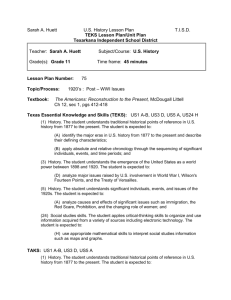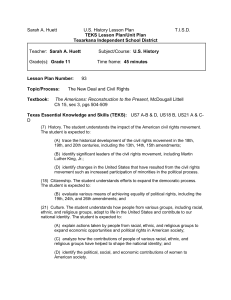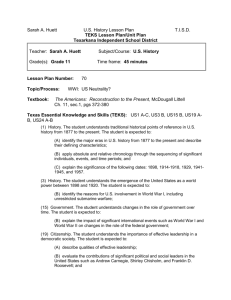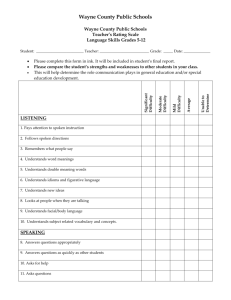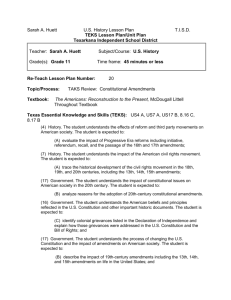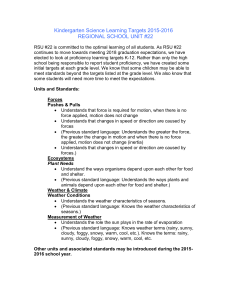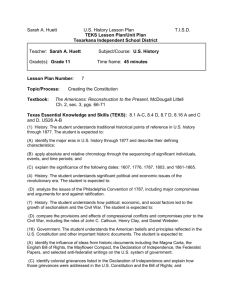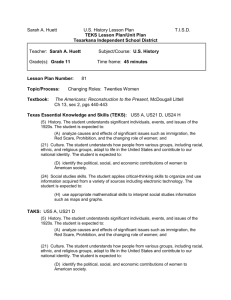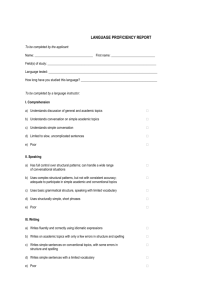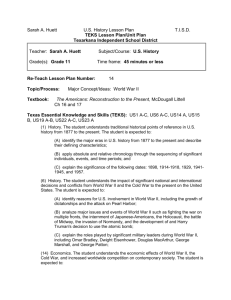Lesson Plan 58.doc - Texarkana Independent School District
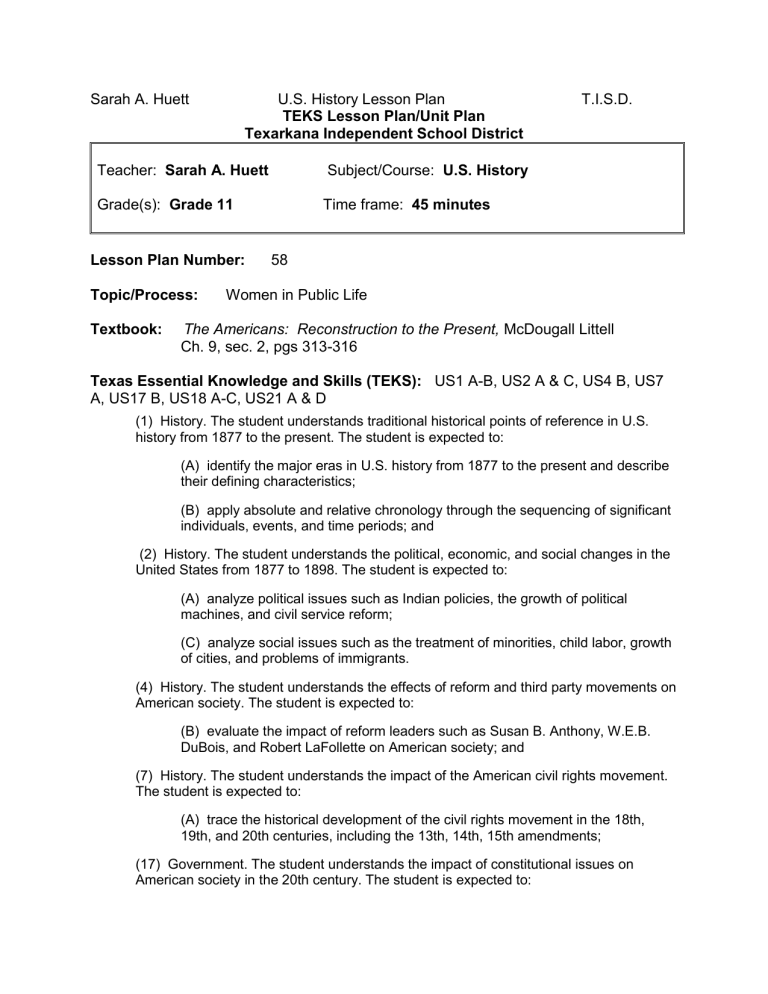
Sarah A. Huett U.S. History Lesson Plan
TEKS Lesson Plan/Unit Plan
Texarkana Independent School District
Teacher: Sarah A. Huett Subject/Course: U.S. History
Grade(s): Grade 11 Time frame: 45 minutes
T.I.S.D.
Lesson Plan Number: 58
Topic/Process: Women in Public Life
Textbook: The Americans: Reconstruction to the Present, McDougall Littell
Ch. 9, sec. 2, pgs 313-316
Texas Essential Knowledge and Skills (TEKS): US1 A-B, US2 A & C, US4 B, US7
A, US17 B, US18 A-C, US21 A & D
(1) History. The student understands traditional historical points of reference in U.S. history from 1877 to the present. The student is expected to:
(A) identify the major eras in U.S. history from 1877 to the present and describe their defining characteristics;
(B) apply absolute and relative chronology through the sequencing of significant individuals, events, and time periods; and
(2) History. The student understands the political, economic, and social changes in the
United States from 1877 to 1898. The student is expected to:
(A) analyze political issues such as Indian policies, the growth of political machines, and civil service reform;
(C) analyze social issues such as the treatment of minorities, child labor, growth of cities, and problems of immigrants.
(4) History. The student understands the effects of reform and third party movements on
American society. The student is expected to:
(B) evaluate the impact of reform leaders such as Susan B. Anthony, W.E.B.
DuBois, and Robert LaFollette on American society; and
(7) History. The student understands the impact of the American civil rights movement.
The student is expected to:
(A) trace the historical development of the civil rights movement in the 18th,
19th, and 20th centuries, including the 13th, 14th, 15th amendments;
(17) Government. The student understands the impact of constitutional issues on
American society in the 20th century. The student is expected to:
Sarah A. Huett U.S. History Lesson Plan T.I.S.D.
(B) analyze reasons for the adoption of 20th-century constitutional amendments.
(18) Citizenship. The student understands efforts to expand the democratic process.
The student is expected to:
(A) identify and analyze methods of expanding the right to participate in the democratic process, including lobbying, protesting, court decisions, and amendments to the U.S. Constitution;
(B) evaluate various means of achieving equality of political rights, including the
19th, 24th, and 26th amendments; and
(C) explain how participation in the democratic process reflects our national identity.
(21) Culture. The student understands how people from various groups, including racial, ethnic, and religious groups, adapt to life in the United States and contribute to our national identity. The student is expected to:
(A) explain actions taken by people from racial, ethnic, and religious groups to expand economic opportunities and political rights in American society;
(D) identify the political, social, and economic contributions of women to
American society.
TAKS: US1 A-B, US2 C, US4 B, US7 A, US18 B, US21 A & D
(1) History. The student understands traditional historical points of reference in U.S. history from 1877 to the present. The student is expected to:
(A) identify the major eras in U.S. history from 1877 to the present and describe their defining characteristics;
(B) apply absolute and relative chronology through the sequencing of significant individuals, events, and time periods; and
(2) History. The student understands the political, economic, and social changes in the
United States from 1877 to 1898. The student is expected to:
(C) analyze social issues such as the treatment of minorities, child labor, growth of cities, and problems of immigrants.
(4) History. The student understands the effects of reform and third party movements on
American society. The student is expected to:
(B) evaluate the impact of reform leaders such as Susan B. Anthony, W.E.B.
DuBois, and Robert LaFollette on American society; and
(7) History. The student understands the impact of the American civil rights movement.
The student is expected to:
(A) trace the historical development of the civil rights movement in the 18th,
19th, and 20th centuries, including the 13th, 14th, 15th amendments;
Sarah A. Huett U.S. History Lesson Plan T.I.S.D.
(18) Citizenship. The student understands efforts to expand the democratic process.
The student is expected to:
(B) evaluate various means of achieving equality of political rights, including the
19th, 24th, and 26th amendments; and
(21) Culture. The student understands how people from various groups, including racial, ethnic, and religious groups, adapt to life in the United States and contribute to our national identity. The student is expected to:
(A) explain actions taken by people from racial, ethnic, and religious groups to expand economic opportunities and political rights in American society;
(D) identify the political, social, and economic contributions of women to
American society.
Concepts
Change
Enduring Understandings/Generalizations/Principles
The student will understand that
Change often occurs as a result of conflict. Change is inevitable. Change can be positive or negative. Change often occurs as a result of technology.
Reform
Equality
Reform often occurs as a result of conflict.
Desire for equality may lead to conflict or change. True equality often does not exist.
Sequence of Activities (Instructional Strategies):
1. Focus Activity: Have students use their textbook to quickly answer the following questions:
What types of jobs were (lower class, middle/upper class, African American, immigrant) women likely to hold?
What types of educational opportunities existed for middle/upper class women?
How did these opportunities affect their lives?
Discuss these topics with the class.
2. Cooperative Learning Activity: Have student read and take notes on the strategies of early suffragist, the results of those strategies and the events leading up to the passage of the 19 th amendment. Briefly go over these topics with the students to ensure understanding.
3. Activity: Depending upon time constraints, give students a choice of one (or more) of the following activities:
A) The Status of Woman: Have students read excerpts of this Susan B.
Anthony article and answer accompanying questions.
Sarah A. Huett U.S. History Lesson Plan T.I.S.D.
B) Cartoon/Poster Analysis: Have students analyze women’s suffrage cartoons/posters and answer accompanying questions.
C) Biography: Have students read a brief biography of one of the following women: Susan B. Anthony, Mary Elizabeth Lease, or Carrie Chapman
Catt. Have questions that the students can answer after the read the biography.
Questions to Consider in Lesson:
1) What job opportunities prompted more women to finish high school?
2) What strategies might women have tried that would have been more successful in the suffrage movement?
Assessment of Activities:
Classroom Observation
Notes
Activity Questions
Prerequisite Skills:
1. Note taking skills
2. Primary source analysis
Key Vocabulary:
NACW, suffrage, Susan B. Anthony, NAWSA, Carrie Chapman Catt, 19 th amendment
Materials/Resources Needed:
Textbook, pens, paper, copies of Anthony excerpts, copies of poster/cartoons, copies of biographies
Modifications: Allow students to have extended time to complete activities. Follow all modifications on student’s IEP. Paired reading.
Differentiated Instruction: Have students create a cartoon or write an editorial either in favor of or against women’s suffrage.
Sarah A. Huett
Teacher Notes:
U.S. History Lesson Plan T.I.S.D.
Copies of brief biographies, posters/cartoons and The Status of Woman should all be relatively easy to find on the internet.
Sample Test Questions:
1. Suffrage
A. discrimination
B. women’s rights
C. the right to vote
D. the denial of the right to vote
2. Susan B. Anthony
A. discovered a new comet
B. leader in the women’s suffrage movement
C. first American woman to earn a professional degree
D. first American woman elected to a national political office
Project developed and delivered through a Collaborative research Grant between
Texarkana Independent School District and TAMUT Regents’ Initiative.
